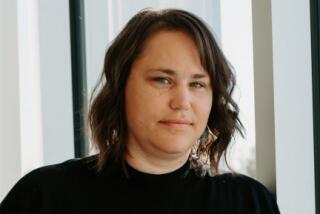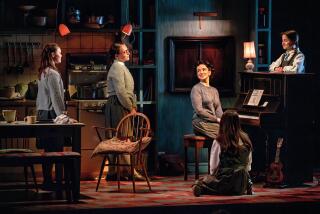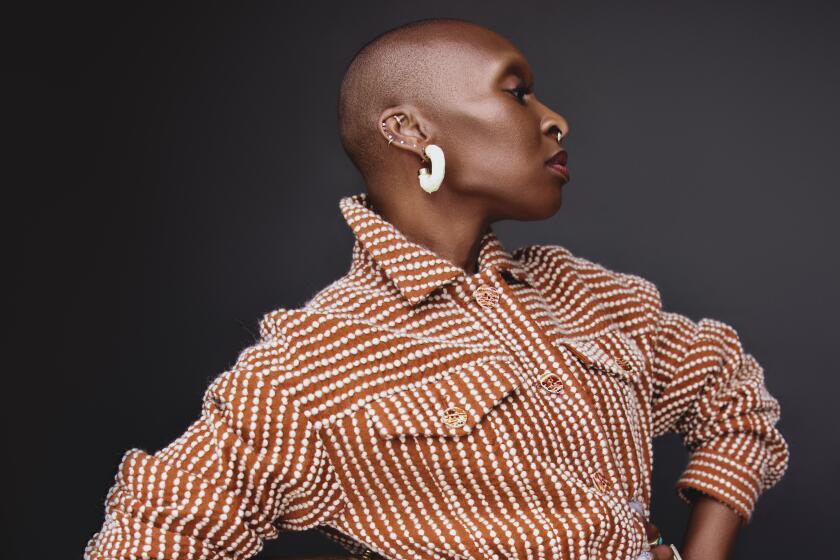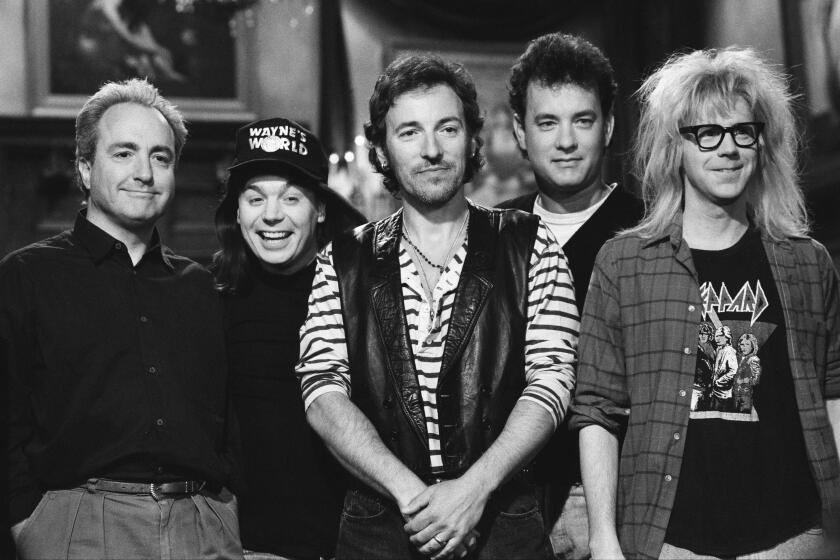Album of a Native American Past
- Share via
In Diane Glancy’s new play, “Jump Kiss: An Indian Legend,” the characters recall pivotal experiences, introduce Native American myths and ruminate on the ineffable--sometimes intertwining, sometimes overlapping--in an often stream-of-consciousness manner. So it’s not surprising that the first question people might ask her is: “What is it?”
Even Glancy admits “it’s such a collage of unrelated, almost unrealized moments.”
Based loosely on Glancy’s life, the play conveys a girl’s memories of growing up in Kansas in the 1950s, the daughter of an English-German mother and a Cherokee father, and of later becoming a mother herself. The fragmentary way the play is presented--an attempt to replicate the scattered and unpredictable way memory works--may confound some audiences, but the playwright believes there is a payoff.
“When you let it flow over you, when you see it in its totality, there is something concrete there, there’s a unity,” says Glancy, speaking by phone from St. Paul, Minn., where she teaches Native American literature and creative writing at Macalester College. “Something concrete comes in a very abstract way.”
“Jump Kiss” is the first play to be staged as part of the Native Voices theater project at the Autry Museum of Western Heritage. The program, launched in 2000, is designed to develop and present plays by or about Native Americans. Three plays were workshopped in March 2001. “Jump Kiss,” the first of the plays to be fully produced, will receive its world premiere at the Autry’s Wells Fargo Theatre on Wednesday.
Glancy originally wrote the play for one voice, but during the workshop process the parts were separated.
“Jump Kiss” lacks a traditional plot line, and the narrator serves not only as a guide and commentator, but also as a character taking part in the action. Often the action helps clarify what’s going on. For example, when Mother, Father, Sister and Brother go for a car ride, the four actors crouch down in two rows, one behind the other. When one character says, “I hear the low, wild whine of the car and house as we hump the farmroad,” the family members jog up and down as if tossed by a bump on the road. The sets are minimal--four chairs and a table to suggest a kitchen--but during the play, three screens project about 300 photographs, which include images of Glancy’s family, taken by the playwright’s mother, Edith Wood Hall.
“Sometimes I think, jokingly, I’m in the Jackson Pollock school of drama, where you just dribble words here and there,” Glancy says, “and somehow if you stand back far enough, they connect, a kind of surreal gathering of scenes.”
The task facing cast members, says director Randy Reinholz, was to help the audience visualize Glancy’s expressionistic language. A man with a calm manner and boyish face, Reinholz, an assistant professor of theater at San Diego State University, is of Choctaw descent. Along with his wife, Jean Bruce Scott, he founded the Native Voices Theatre Company in 1993, and after directing “Urban Tattoo” at the Autry in 1999, he and Scott were invited to set up the Native Voices program at the museum.
“The writing is gorgeous, it’s so evocative,” Reinholz says during a break in rehearsals. “At first we didn’t understand how it would be staged--that was the challenge of this piece.”
Actress Tonantzin Carmelo, who plays Sister, and Gil Birmingham, who plays Father, have been involved with “Jump Kiss” since workshops last year, giving them more time to reflect on the play’s framework.
“I see the individual pieces like photographs, and we are bringing these photographs to life,” Carmelo says. “During the play, she’s in a plane, looking at photographs, letting her mind wander as it would naturally. It’s like when you see a photo album, you can put together pieces of a person’s life, although maybe not the whole picture.”
For Birmingham, the play addresses “how important it is to know who you are--because there’s an external world that’s very lost; how you hold your core to live a meaningful and purposeful life.”
Like the central character in the play, the 61-year-old Glancy grew up in Kansas, the daughter of a domineering homemaker mother and a quiet father, who worked in a slaughterhouse and learned to assimilate into the mainstream culture.
Although her Native American heritage was pushed into the background during her youth, Glancy still sensed the importance of her roots. She later did her own research and, for a time, moved to Oklahoma and lived near her ancestral land.
Growing up, she sensed a repression and a conflict that she suggests in “Jump Kiss.” In one scene, Father says, “How do you forget your voice? How do you fit two worlds together that don’t fit? By ignoring the one you are, and going with the other. Forgetting your voice. Forgetting your Indian past.”
Her mother, Glancy acknowledges, was repressed as well. “My mother was a very intelligent woman, but she was very stifled as women were in those days,” she says. “She had a creative imagination and didn’t know what to do with it--it made her very angry sometimes. But her photographs, that was her outlet I would say.” Then she adds, “My play is a supplement of her photo album. Now it’s my turn, I get to say what I want to say.”
While episodes in the play are largely based on real events, Glancy says, “there’s fiction in there also.” For example, one scene revolves around the family helping aging grandparents move from their longtime homestead. “Some of it is very concrete--moving the grandparents from the farm takes all day,” Glancy says. “Then they’re digging up the house and moving it; it’s very bizarre. Of course they really didn’t do that, but [it suggests] the uprooting of the past. The interconnected imagery shows up again and again in different ways.”
The fluidity of imagery has long been Glancy’s calling card. She is the author of several books of poetry and plays. Her 1996 novel, “Pushing the Bear,” told about the Trail of Tears of 1838-39, when the federal government forced the Cherokees to abandon their traditional lands in North Carolina, Georgia and Tennessee for the Indian Territory (now Oklahoma). Coming out this fall is another book of plays, “American Gypsy,” which will include “Jump Kiss.”
In her works, Glancy attempts to weave “the seen and the unseen world,” she says. “In the past, the ancestors can show up at anytime; it’s a living, fluid narrative. Tribes [and their narrative traditions], of course, differ so much, but there are some similarities--this relaxing of boundaries is pretty typical, as well as the love of story, the importance of words.”
What does “jump kiss” mean? Everyone seems to have his own definition.
“There are moments in your life and time when you get a little jolt--it’s part passion and part danger--and it makes you feel alive; it makes you think about things you normally don’t think about,” director Reinholz says.
“It reminds me of that line from the Jimi Hendrix song ‘excuse me while I kiss the sky,’” Birmingham says. “‘Jump Kiss’ to me is the exhilaration you have when you transcend human bounds, when we become who we really are and understand the value of our relationship with one another.”
Says Glancy, “It could be riding on a plane, it could be the memory of my son playing basketball. It’s the theory of playwriting, that world I can’t quite reach, but it is certainly there.”
The play begins and ends with a reference to the spider, which in Native American lore serves as a metaphor for a weaver of tales, of connectedness.
“That’s what I wanted to present on stage, the filaments of the spider’s web.”
*
“JUMP KISS: AN INDIAN LEGEND,” Wells Fargo Theatre at the Autry Museum of Western Heritage, 4700 Western Heritage Way, L.A. Dates: Opens Wednesday at 8 p.m. Regular schedule: Thursdays-Saturdays, 8 p.m.; Sundays, 2 p.m. (June 8 at 2 p.m. only.) Closes June 23. Price: $15. Phone: (323) 655-8587.
*
Scarlet Cheng is a regular contributor to Calendar.
More to Read
The biggest entertainment stories
Get our big stories about Hollywood, film, television, music, arts, culture and more right in your inbox as soon as they publish.
You may occasionally receive promotional content from the Los Angeles Times.










